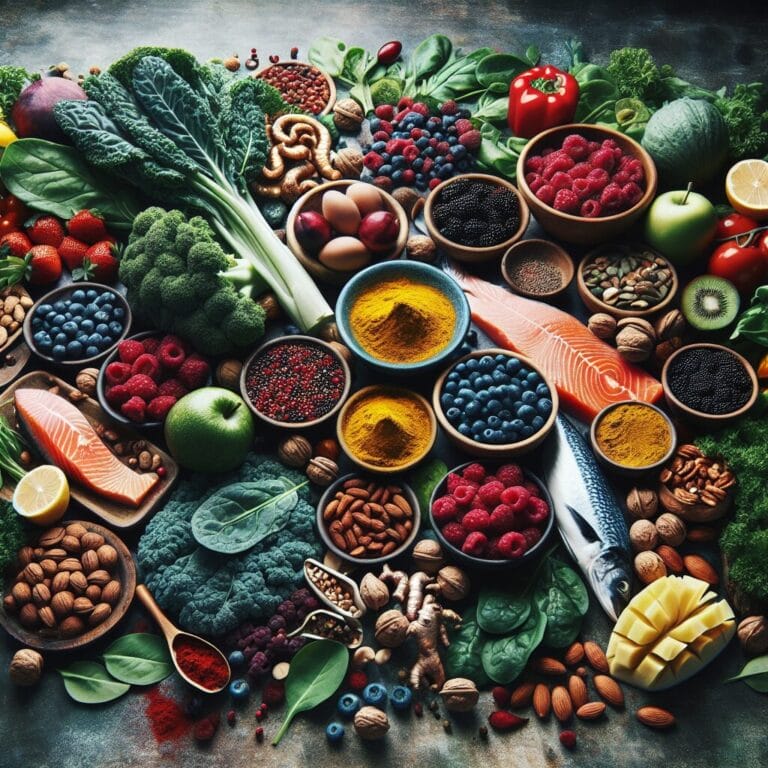
Combating Chronic Pain: How Healthy Eating Habits Can Help
Table of Contents
- Introduction
- The Impact of Nutrition on Chronic Pain
- Developing Healthy Eating Habits
- Anti-Inflammatory Foods and Chronic Pain
- Foods to Avoid or Limit
- The Role of Hydration in Pain Management
- Supplements and Chronic Pain
- Lifestyle Changes to Complement Healthy Eating
- Case Studies and Success Stories
- Conclusion
- Frequently Asked Questions
Introduction
Good news, folks! Eating habits can play a superhero role when you’re wrestling with constant pain. Imagine your body like a fancy car; what you fill the tank with can either rev up your engine or gum up the works. For those dodging the ouches of chronic pain, munching on anti-inflammatory foods is like high-quality fuel. Think about tossing some fatty fish onto your plate; they’re swimming in omega levels that can help reduce inflammation. Or, drizzle olive oil on your salad—you’ll feel fancier and it’s a good source of anti-inflammatory goodness. If rheumatoid arthritis is your uninvited dance partner or migraine headaches crash your party, loading up on fruits, vegetables (hello, cruciferous superheroes), and healthy proteins might just give you an edge in pain management.
Plus, if we’re talking about salad dressing (and why wouldn’t we?), skip the added sugar—it’s not doing any favors for your inflammation situation. Instead, go full Mediterranean diet to keep things as chill as possible inside those body tunnels of yours. Remember to drink plenty of water too—your cells will thank you by lessening inflammation and helping to relieve pain symptoms. So let’s make those eating habits count and show chronic fatigue syndrome and other pain bullies that they don’t get to win!
The Impact of Nutrition on Chronic Pain
Hey there, did you know that what’s on your fork might be fueling the fire of chronic pain? It’s true! Certain munchies can actually fan the flames of those aches and make them worse. Let’s dive into some bite-sized nuggets of truth. While noshing on foods high in sugar and saturated fats might seem yummy, they’re like throwing logs onto your body’s inflammation bonfire. It sounds harsh, but think about it—foods like processed snacks or sugary treats are no friends to our insides.
On the flip side, chowing down on goodies rich in vitamins and minerals could be just the cape-wearing heroes we need. For instance, magnesium – found in dark chocolate (yep, you read that right!) and leafy greens – is a star player in reducing muscle aches. And how about turmeric? This golden spice isn’t just for lattes; it packs a punch against pain with its anti-inflammatory superpowers.
But wait, there’s more! Have you ever thought that vitamin D could be your secret weapon? Soaking up some sunshine and eating egg yolks or fortified foods can help kick pain to the curb because low levels of this sunny vitamin have been linked to more ouch moments for folks with conditions like fibromyalgia.
Now let’s talk zinc – an unsung hero when it comes to boosting your body’s defense squad against pain. Meat, seeds, and nuts are where this mineral hangs out waiting to jump into action.
And don’t forget about antioxidants; these cellular defenders wage war against free radicals that can cause inflammation. Berries are bursting with them, so add a handful to your snack routine for a tasty way to fight back against constant pain.
So next time you’re at the market strolling down the aisles, think about how each food item could either be your ally or enemy in the battle against chronic pain. A healthy diet brimming with anti-inflammatory warriors—like fruits vegetables galore, fatty fish sporting omega levels of champions, cruciferous veggies standing tall—and staying hydrated by drinking water like it’s going out of style may help keep chronic fatigue syndrome and migraine headaches from ruling your world. Remember: every little bit helps when it comes to managing those pesky pain symptoms!

Developing Healthy Eating Habits
Dive into the colorful world of the food pyramid and you’ll find it’s more than just a pretty rainbow of meal suggestions—it’s your secret map to a pain-busting treasure trove! For those facing the dragon of chronic pain, every layer of this pyramid has hidden gems. From the sturdy base filled with whole grains that keep your energy steady without poking at inflammation, to the peak where sweets sit (spoiler alert: too many can lead to treacherous lands filled with added sugars and pain flares), understanding how each level affects inflammation is key.
A balanced diet isn’t just about keeping your jeans happy; it’s also about armoring up against chronic aches. Think of it like assembling a superhero team—every nutrient has its unique power in guarding against rheumatoid arthritis or calming the storms of migraine headaches. You want healthy proteins flexing their muscles alongside anti-inflammatory heroes like leafy greens and berries. And don’t forget to invite omega levels from fatty fish for their extraordinary ability to lessen inflammation.
But hey, before you go tossing everything into your cart willy-nilly, let’s talk tactics. Meal planning can be as fun as charting a course for buried treasure—especially when X marks the spot for pain relief! Start by plotting out meals rich in cruciferous vegetables, add splashes of olive oil for smooth sailing, and always plot courses around Mediterranean diet-friendly ports. And what’s our secret weapon? Water! Keep drinking water throughout your adventure because staying hydrated is like having an ace up your sleeve when you’re battling against constant pain.
So arm yourself with these practical tips: swap out processed foods that are no good guys for whole fruits and veggies; balance each plate like you’re balancing on a pirate ship’s mast – careful not to tip too far towards one food group or another; and prepare snacks that’ll keep you fueled on your journey without feeding the flames of discomfort. With these strategies in your compass, managing chronic pain might just feel like finally finding that hidden treasure!
Anti-Inflammatory Foods and Chronic Pain
Embarking on a journey to outsmart chronic pain, it’s time to cast our nets wider and scoop up some oceanic allies—hello, omega-3 fatty acids! These slick swimmers of the sea don’t just make waves; they make a splash in reducing inflammation. Found in the likes of salmon, mackerel, and even algae for the veggie-loving pirates among us, these fats tell those inflammatory responses to walk the plank. By incorporating these marine marvels into your grub, you’re setting sail toward calmer waters where constant pain is but a whisper on the horizon.
In this treasure hunt for pain-relief gems, let’s not forget about the antioxidant armada. These trusty nutrients are like scouts sent out to patrol our body’s nooks and crannies for pesky oxidative stress—the kind that can start scuffles leading to ouches and aches. To rally your own troop of antioxidants, recruit colorful characters like blueberries, spinach, and nuts into your crew. They’ll stand guard against free radicals with vigilance worthy of any knight in shining armor.
But wait—there’s an aromatic twist in our tale! Spices like ginger and cinnamon aren’t just there to jazz up your taste buds; they wield their anti-inflammatory sorcery with ancient wisdom. A sprinkle here and a dash there could be all it takes to keep nagging pains at bay as part of your culinary pain management toolkit. These spice rack heroes are ready to play nice with your fruits vegetables medley or even join forces with olive oil as a flavor-packed salad dressing without added sugar.
As we navigate through the healthy diet archipelago, remember (but not too much!) that every morsel from cruciferous vegetables to healthy proteins and beyond holds potential power over chronic fatigue syndrome or rheumatoid arthritis skirmishes. So hoist your plates high, adventurers—it’s time to discover how anti-inflammatory foods guide us towards new dawns free from the shadows of migraine headaches and chronic pain eat away at life’s joys. And never underestimate the might of drinking water; it’s like pouring peace over troubled areas within. With each sip and bite aligning with the Mediterranean diet stars above us, we find our compass ever pointing toward hope—a life where lessening inflammation isn’t just good news; it’s reality!
Foods to Avoid or Limit
Picture this: Your body is like a bustling city, and what you eat are the visitors that come in. Some tourists, like trans fats found in junk food and sugary sodas, litter the streets with trash (inflammation) causing traffic jams and chaos (pain flares). Now think of your cells as tiny workers trying to clean up the mess—eating healthy gives them the right tools for the job! By waving goodbye to processed foods packed with unhealthy oils, we essentially help our cellular crew keep inflammation from clogging our bodily byways.
And sugar? Well, it’s a sneaky little gremlin that loves to stir up trouble. It might taste like sweet harmony on your tongue, but once inside, sugar can crank up inflammation’s volume dial. It’s not just about avoiding candy; added sugars are lurking in places you might not expect—like salad dressing or bread. Sticking to an anti-inflammatory diet means playing detective with labels to ensure these hidden culprits don’t sneak into your cart.
On the flip side of those bad-news bears are fats playing for team Good Vibes. While some oils get a thumbs down (I’m looking at you, vegetable oil), there’s a celebrity among fats: olive oil! Swapping out less helpful oils for this liquid gold can be a game-changer for anyone battling chronic pain eat woes. Plus, let’s hear it for fatty fish and their high levels of omega-3s; they’re like peacekeepers sending calm signals throughout your body.
So let’s get smart with our fats and sugars – treating them like players on a game board where every move counts towards winning against rheumatoid arthritis or migraine headaches. A healthy diet is more than munching on fruits vegetables galore; it’s also knowing which guests to invite into our city-bodies so we can hustle through life with fewer “ow!” moments and more “wow!” days. And remember—tossing back plenty of drinking water helps flush out unwanted visitors before they start trouble! Keep these tips close to heart: small changes in eating habits can bring big waves of relief to those riding the chronic pain tides.
| Food Type | Description | Effects on the Body | Alternatives |
|---|---|---|---|
| Trans Fats | Found in junk food like chips, baked goods, and fast food | Can cause inflammation and exacerbate pain conditions | Opt for whole foods and snacks with healthy fats |
| Sugary Sodas | High in added sugars and often lack nutritional value | Can increase inflammation in the body | Drink water, herbal teas, or diluted natural fruit juices |
| Added Sugars | Common in processed foods like salad dressings, bread, and sauces | May contribute to inflammation and related health issues | Read labels and choose products with no added sugars |
| Unhealthy Oils | Includes some vegetable oils and hydrogenated oils | Can lead to increased inflammation and chronic pain | Use olive oil or oils rich in omega-3s like flaxseed oil |
| Fatty Fish | Rich in omega-3 fatty acids, such as salmon, mackerel, and sardines | Help reduce inflammation and can have a calming effect on the body | Include as part of a balanced diet, especially for those with chronic pain |
The Role of Hydration in Pain Management
Picture your body as a bustling hub of activity, with all kinds of processes happening non-stop. Now imagine what happens when this hub runs low on water. Dehydration sneaks in, making everything creakier and more prone to hurt like heck! That’s right—parched cells and joints can lead to a pain party nobody wants an invite to. Keeping hydrated is essential for diluting the bad guys that amp up ache levels, such as nasty toxins and irritants. Sipping on H2O regularly isn’t just refreshing; it acts like a soothing elixir for our body’s intricate network, ensuring that those pesky pain signals don’t get any extra ammo because of thirst. So grab that water bottle and keep it close—it’s your trusty sidekick in the daily quest to quell chronic discomforts from rheumatoid arthritis flares to migraine meltdowns.

Supplements and Chronic Pain
Did you know that certain vitamins and minerals can be like super sidekicks in your quest to quash chronic pain? For instance, Vitamin C isn’t just for dodging colds—it helps in repairing your tissues and easing the ache of rheumatoid arthritis. Meanwhile, Calcium stands guard, keeping bones strong so that aches don’t turn into full-blown attacks. But before you dash off to the supplement aisle, it’s wise to chat with a health pro. They’ll help ensure these helpers don’t clash with other meds or conditions.
Herbal supplements are also climbing the charts as popular pain pals, with some folks singing praises about turmeric capsules and willow bark extract for their potential to lessen inflammation. Yet, while these plant-based buddies have fans, it’s key to remember they’re part of the band—not solo stars. Mixing them into an already rocking anti-inflammatory diet could lead to an encore of relief from constant pain symptoms.
When pondering these herbal allies for your battle against discomfort—like waving goodbye to added sugar or hello to healthy proteins—do a little homework first. Some might not jive well with medications you’re taking or health issues you’re facing. And never forget: while gulping down herbal supplements might seem like a shortcut through Pain Forest, planting your feet firmly on the path of balanced eating habits often leads to safer travels over time.
As we navigate this journey of managing chronic pain eat woes, with olive oil glistening in our salad dressing and fatty fish gracing our plates alongside colorful fruits vegetables galore, let’s toast (with water, mind you) to the new knowledge we’ve gained! Life’s merry Mediterranean diet—packed with good sources of anti-inflammatory foods and high levels of omega levels—beckons us toward better days where lessening inflammation isn’t just good news; it’s reality!
Lifestyle Changes to Complement Healthy Eating
Did you know that fighting chronic pain is like a tag-team wrestling match? It’s not just about what we chow down—our muscles and joints crave movement to stay limber and pain-free. Regular exercise boosts our body’s natural painkillers, endorphins, which can turn the tide in the battle against constant pain. Teaming up a healthy diet with staying active creates a dynamic duo that can relieve pain and lessen inflammation more effectively than either could alone.
And here’s another tag-team partner for our diet: stress management! Less stress means less tension in our bodies, leading to fewer pain signals being sent out. When we keep calm through techniques like deep breathing or meditation, it helps our anti-inflammatory diet do its job even better by creating an environment where healthy proteins and omega levels from fatty fish thrive.
But wait, there’s one more sleeper agent in this fight against chronic pain eat woes—sleep itself! Catching enough Zzzs is critical because while we’re dreaming of salad dressing with the perfect drizzle of olive oil (no added sugar!), our bodies are busy repairing tissues and resetting sensitive nerve endings. Combine good sleep with a Mediterranean diet rich in fruits vegetables and cruciferous superheroes, along with ample drinking water, and you’ve got yourself a trifecta of defense against migraine headaches, rheumatoid arthritis flare-ups, and overall chronic fatigue syndrome. So as we journey towards managing chronic pain, let’s embrace these allies—diet, exercise, stress relief, and snooze time—to rediscover joys nibbled away by nagging aches.
Case Studies and Success Stories
Ever wonder how some folks dance through life, sidelining constant pain with a forkful of savvy choices? Let’s dish out a story that sparkles with such magic. Meet Jamie – once shadowed by chronic fatigue syndrome and migraine headaches, she turned her plate into a canvas of vibrant fruits vegetables and heart-hugging fatty fish. No more reaching for salad dressings dripping with added sugar; Jamie now swears by the drizzle of olive oil and the zip from herbs. And guess what? Her pain symptoms eased up! By latching onto an anti-inflammatory diet rich in cruciferous vegetables and healthy proteins, while keeping hydrated, she transformed her eating habits into pain-busting superpowers. Jamie’s tale isn’t just good news; it’s a testament to how making friends with foods that reduce inflammation can lead to fewer “ouch” days and more play. So there you have it—a sprinkle of real-life zest showing us that wielding the mighty tools of a Mediterranean diet might just be our secret handshake into the less-pain-more-gain club!
Conclusion
Did you know that your gut might just be the secret command center for battling chronic pain? That’s right, our digestive system does more than just break down those tasty bites—it also holds sway over inflammation. Packed with good bacteria, the gut can don a superhero cape and fight the evil inflammation that often leads to constant pain. So, keeping your microbiome merry with probiotic-rich foods like yogurt could be your ticket to lessening those pesky pain symptoms. And let’s not forget prebiotics! Found in garlic, onions, and bananas, these fibers are the ultimate sidekick, nourishing the friendly bacteria and reinforcing your anti-inflammatory diet. Just imagine: indulging in a Greek salad sprinkled with walnuts isn’t only delicious but might also give you an upper hand against rheumatoid arthritis or migraine headaches—a bite-sized step towards a life of lesser aches!



